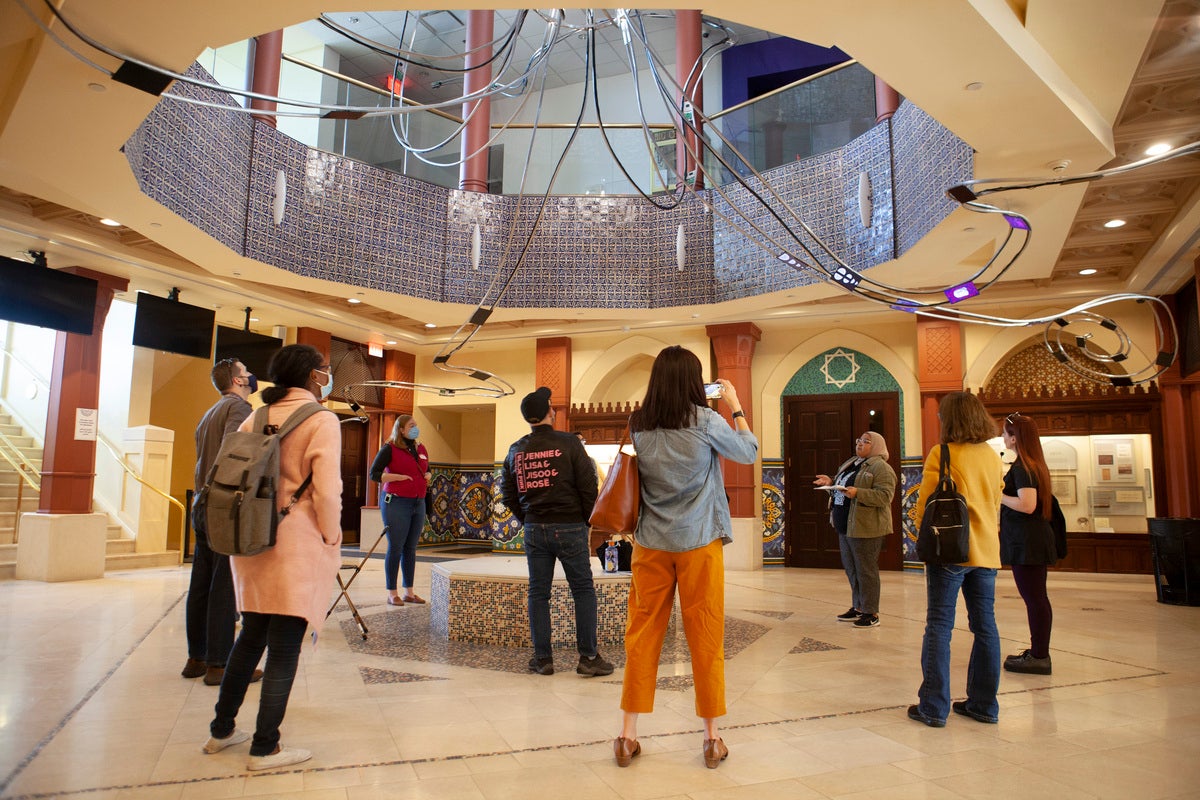Beyond a museum’s echoing hallways and hallowed exhibits are unseen opportunities for visitors to engage with the story of their own communities. Whether that’s organizing workshops or inviting the community to participate in an art project, museums and other cultural institutions are looking for ways to connect more deeply with their communities. Some are embracing the idea of “creative placemaking,” a framework for organizations to use the arts and their programming to help make their own communities more inclusive and welcoming places.
One of Wallace’s Advancing Well-Being in the Arts grantees, the Arab American National Museum (AANM) located in Dearborn, Michigan, has been incorporating placemaking in their community outreach and programming.
At a recent panel sponsored by the American Alliance of Museums, AANM—alongside the First Americans Museum, the Fredericksburg Area Museum, and the Science Museum of Minnesota—discussed their experience with this approach.
In 2021, AANM launched “Spaces of Dearborn,” van tours that spotlight the city’s vernacular architecture, or buildings that were designed and created based on the needs of the immediate community and reflective of local or cultural traditions. In a city where over half the population identifies as Middle Eastern or North African, these tours bring attendees to the homes of community members, mosques, and local businesses to see how Arab Americans have made Dearborn their home with architecture and design that merges Arab motifs with mid-century Victorian styles.

In developing “Spaces of Dearborn,” museum staff knocked on doors in neighborhoods, connecting with local businesses and homeowners to gather oral histories, build relationships, and invite them to participate in the program.
“As I thought out what the tour would look like from the audience perspective, the lines between community, audience, tour guides, and participants began to blur,” said Fatima Al-Rasool, AANM’s public programming coordinator. “The ‘experts’ on Dearborn vernacular architecture weren’t found in research books and essays: they were in the homes and buildings of Dearborn!”

The relationship started through door-knocking and meeting people very organically, but it has blossomed into long-term relationships with people in my community. It’s been a real joy to work with our community in a way that uplifts their stories and narratives.
— Fatima Al-Rasool
The museum continues to investigate ways to improve and deepen the engagement between the museum and its neighbors. According to Al-Rasool, all the community members that participated as destinations on the “Spaces of Dearborn” tour continue to welcome the museum back into their homes and businesses.
“The relationship started through door-knocking and meeting people very organically, but it has blossomed into long-term relationships with people in my community. It’s been a real joy to work with our community in a way that uplifts their stories and narratives,” said Al-Rasool.
For the Fredericksburg Area Museum, the idea of placemaking has also involved reparative work addressing the painful histories of a town and its impact on future generations, particularly in communities of color. The town of Fredericksburg in Virginia had been debating the fate of a stone block in the center of town, known as the Auction Block, that was associated with the sale of enslaved people. Gaila Sims, Ph.D., the vice president of programs and interpretation, said the process of moving the Auction Block from the streets of Fredericksburg into their museum around the corner made sure to incorporate community feedback and acknowledge the community’s painful history.
Through focus groups, public forums, and community meetings, the city found that for many, the Auction Block served as a symbol of the ongoing pain of racial injustice and that any exhibit had to address this fact. The museum designed ways to include this historical context. It also created a “community wall” to offer visitors an opportunity to share their own reflections, thoughts, and stories.

“Every day, there’s a new reflection that’s really thoughtful and shows how engaged people are with the exhibit; we’re proud that people feel comfortable enough in the museum to feel safe contributing,” said Sims. “I like to think of the auction block as the kind of catalyst for a community-wide transformation of how we do public history in Fredericksburg. Through the wall, visitors have a space to understand that all of our ideas, our memories, and our stories about that object are an important part of its interpretation, too.”
Through associating stories with objects and places in this way, organizations can help foster a sense of history and belonging for visitors. This can also lead to more enduring relationships with their neighbors–and, ultimately, help make the community stronger.
Photos by Houssam Mchaimech. Spaces of Dearborn: Architecture Tour - Oct. 1, 2022, Arab American National Museum.




